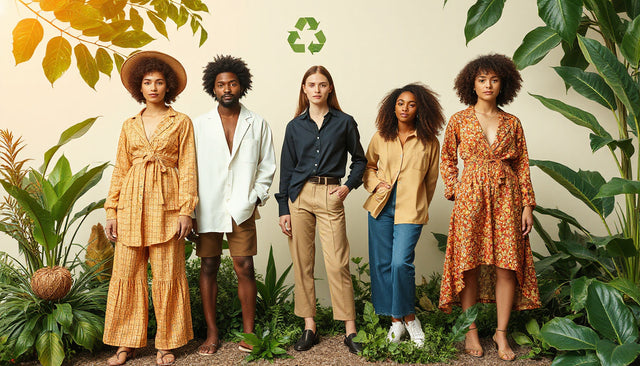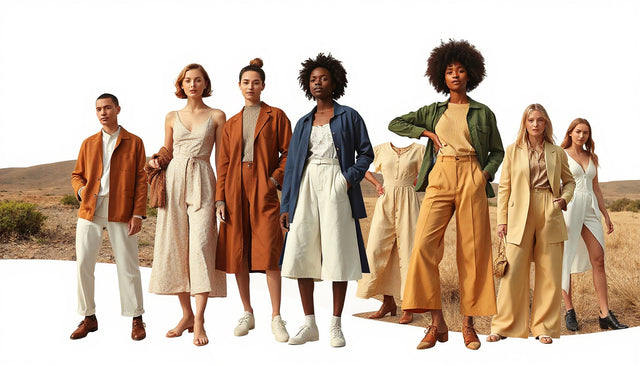The fashion industry faces change. Urgent social and environmental challenges drive it. By 2025, sustainable fashion must work. It supports brands, communities, and our planet. In this article, we explore the key drivers that shape fashion’s sustainable impact by 2025. We study fast fashion’s environmental costs and give clear strategies for consumers and companies.

Why Sustainability Matters More Than Ever in Fashion
Fashion stands strong in the global economy. It earns over $1.3 trillion and employs more than 300 million people. Yet its impact is heavy on the environment:
- Carbon emissions: Fashion gives 2–8% of global emissions and that number may grow.
- Water usage: A cotton shirt uses about 700 gallons of water. A pair of jeans uses up to 2,000 gallons.
- Waste: Each year, 85% of textiles go to landfills or burn, wasting resources.
- Microplastic pollution: Synthetic fabrics release over 500,000 tons of microfibers into the ocean every year.
- Human impact: Many workers, often women in developing countries, face unsafe and unfair conditions.
These impacts mean that 2025 becomes a key year. New rules and ideas must make fashion greener and fairer.
4 Key Drivers of Sustainable Fashion Impact by 2025
1. Strengthening Sustainability Regulations and Corporate Accountability
- The EU’s Ecodesign for Sustainable Products Regulation (starting July 2024) drives brands to use energy-efficient, circular methods.
- The Corporate Sustainability Due Diligence Directive (CSDDD) makes companies fix human rights and environmental risks in their supply chains.
- The U.S. bans PFAS chemicals in apparel from 2025 and enforces Extended Producer Responsibility (EPR) for packaging. Producers must now own complete product life cycles.
These rules force brands to embed sustainability into core strategies.
2. Next-Generation Smart Textiles and Eco-Friendly Materials
- New fabrics from biotechnology, like AMSilk’s Biosteel, plant-based leathers, and materials from eucalyptus, seaweed, or fungi, break old habits.
- These fabrics lower fossil fuel use, reduce degradation, and break down faster than conventional synthetics.
- Shifting from petroleum polyester to renewable alternatives cuts emissions and microplastic waste.
3. Technological Innovations Driving Circularity and Efficiency
- Artificial intelligence sharpens demand forecasts, customizes fits, and plans production. This lowers fabric waste and stops overproduction.
- Blockchain gives clear proof of sourcing and labor practices. It fights counterfeiting and arms consumers with ethical choices.
- Virtual try-on and augmented reality help customers choose well; they lower returns and cut carbon costs.
- Advances in textile-to-textile recycling bring cotton and polyester fibers back into use in a loop.
4. Changing Consumer Mindsets and Purchasing Behaviors
- About 80% of consumers will pay more for sustainable products.
- The secondhand clothing market may double by 2027, led by eco-aware Gen Z buyers.
- More people support local artisans and brands that respect fair labor and the earth.
- Ethics and care for nature now count as top purchase factors for many buyers.
Fast Fashion’s Environmental Toll and the Urgency of Change
Fast fashion uses speed and cheap production, but it harms our world.
It wastes massive water, spills toxic dyes in rivers, and needs many nonrenewable synthetics.
The industry gives us:
- 10% of global carbon emissions.
- Thousands of tons of microplastics in oceans every year.
- Textile waste that burns or dumps like a garbage truck every second.
It also hurts people through dangerous work and chemical risks.
Today, clothes race from design to store in as few as 10 days.
We must choose slow fashion, reselling, renting, and circular production to balance this pace.
Actionable Takeaways: How You Can Support Sustainable Fashion in 2025
Whether you are a buyer, retailer, or brand leader, you can take simple steps.
For Consumers
- Choose quality over quantity: Buy pieces that last.
- Support sustainable brands: Look for clear sourcing and fair labor.
- Buy secondhand or rent: This extends the life of clothing.
- Care for your clothes: Wash less, use cold water, and avoid machine drying.
- Educate yourself: Use apps or sites that show brand records on sustainability.
For Brands and Retailers
- Plan for new rules: Use eco-design, show reports, and check supply chains.
- Use innovative materials: Try plant-based, biodegradable, or recycled fibers.
- Embrace technology: Use AI to cut waste, blockchain for clarity, and virtual tools to help shoppers.
- Adopt circular models: Create programs for reselling, repairing, and recycling.
- Engage consumers: Make sustainable options available and balance cost with ethics.
Conclusion: Embracing Sustainability for a Fashionable Future
By 2025, sustainable fashion will reshape the industry. Tougher rules, new materials, smart technology, and shifting consumer values drive this change. Fashion can cut its environmental impact and improve social outcomes when we all work together.
Remember, each purchase becomes a vote for the world you wish to see. Fashion can work for the good of everyone if we choose sustainability today for a brighter tomorrow.
Explore more about sustainable fashion. Join the push towards a cleaner, fairer industry — because fashion’s future is green.
At Design Delight Studio, we’re committed to sustainable living and ethical fashion. Every article reflects our passion for mindful choices that empower both people and the planet.






















0 comentarios